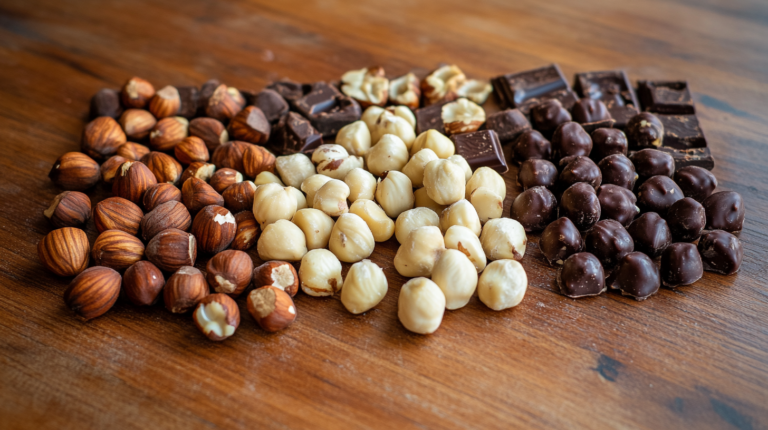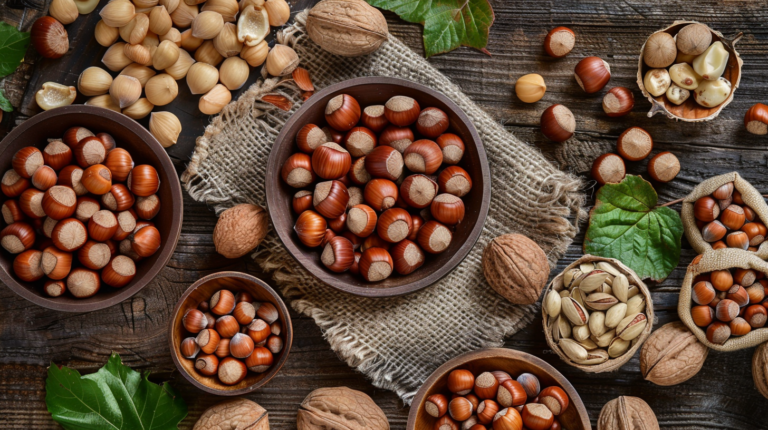Exploring the Different Types of Hazelnuts
Introduction
Hazelnuts, also known as filberts, are a versatile and popular nut crop grown in various parts of the world. Understanding the different varieties of hazelnuts is crucial for growers, hobbyists, and consumers to make informed decisions regarding cultivation, purchase, and use. This comprehensive guide explores the diverse varieties of hazelnuts, their unique characteristics, and their suitability for different climates and purposes.
Overview of Hazelnut Varieties
Hazelnuts belong to the genus Corylus, with the European hazelnut (Corylus avellana) being the most widely cultivated species. Other species, such as the American hazelnut (Corylus americana) and the beaked hazelnut (Corylus cornuta), are also cultivated but to a lesser extent. Varieties of hazelnuts can be broadly classified based on their origin, growth habit, nut characteristics, and resistance to diseases.
European Hazelnut Varieties
European hazelnuts (Corylus avellana) are the most commercially significant and widely cultivated hazelnut varieties. They are known for their large, high-quality nuts and adaptability to different growing conditions. Some notable European hazelnut varieties include:
Barcelona
- Origin: Spain
- Characteristics: Large, round nuts with thick shells and excellent flavor.
- Growth Habit: Vigorous, upright growth with good branching.
- Disease Resistance: Moderate resistance to Eastern Filbert Blight (EFB).
- Uses: Suitable for both fresh consumption and processing.
Ennis
- Origin: United States
- Characteristics: Large, round nuts with thin shells and high kernel percentage.
- Growth Habit: Vigorous, spreading growth with dense foliage.
- Disease Resistance: Susceptible to EFB, requiring management practices for control.
- Uses: Popular for fresh markets and confectionery products.
Tonda Gentile delle Langhe
- Origin: Italy
- Characteristics: Medium-sized, round nuts with thin shells and excellent flavor.
- Growth Habit: Moderate growth with a well-branched structure.
- Disease Resistance: Good resistance to EFB and other common hazelnut diseases.
- Uses: Highly prized for premium confectionery and chocolate products.
Lewis
- Origin: United States
- Characteristics: Medium-sized, round nuts with high kernel percentage and good flavor.
- Growth Habit: Upright, vigorous growth with good branching.
- Disease Resistance: Resistant to EFB, making it suitable for regions with high disease pressure.
- Uses: Suitable for both fresh consumption and processing.
American Hazelnut Varieties
The American hazelnut (Corylus americana) is native to North America and is known for its hardiness and adaptability to various climates. While not as widely cultivated as European varieties, American hazelnuts are valued for their resilience and unique characteristics.
Winkler
- Origin: United States
- Characteristics: Small to medium-sized nuts with thick shells and sweet kernels.
- Growth Habit: Vigorous, spreading growth with dense foliage.
- Disease Resistance: High resistance to EFB and other common hazelnut diseases.
- Uses: Primarily used for wildlife habitat and native plantings, but also suitable for home gardens.
Geneva
- Origin: United States
- Characteristics: Medium-sized nuts with thick shells and good flavor.
- Growth Habit: Upright growth with good branching.
- Disease Resistance: Resistant to EFB and other diseases, making it suitable for diverse growing conditions.
- Uses: Suitable for fresh consumption and processing.
Hybrid Hazelnut Varieties
Hybrid hazelnut varieties are developed by crossing European and American hazelnuts to combine the desirable traits of both species. These hybrids aim to enhance disease resistance, nut quality, and adaptability to different climates.
The Beast
- Origin: United States
- Characteristics: Large, round nuts with thick shells and excellent flavor.
- Growth Habit: Vigorous, upright growth with good branching.
- Disease Resistance: Highly resistant to EFB and other common hazelnut diseases.
- Uses: Suitable for both fresh consumption and processing.
Grand Traverse
- Origin: United States
- Characteristics: Medium-sized, round nuts with thin shells and high kernel percentage.
- Growth Habit: Moderate growth with a well-branched structure.
- Disease Resistance: Good resistance to EFB and other diseases, making it suitable for diverse growing conditions.
- Uses: Popular for fresh markets and confectionery products.
Slate
- Origin: United States
- Characteristics: Small to medium-sized nuts with thick shells and sweet kernels.
- Growth Habit: Upright growth with dense foliage.
- Disease Resistance: Resistant to EFB and other common hazelnut diseases.
- Uses: Suitable for fresh consumption, processing, and home gardens.
Disease-Resistant Varieties
Eastern Filbert Blight (EFB) is a significant disease affecting hazelnuts, particularly in North America. Breeding programs have focused on developing varieties with strong resistance to EFB to ensure sustainable hazelnut production. Some notable disease-resistant varieties include:
Jefferson
- Origin: United States
- Characteristics: Large, round nuts with thin shells and high kernel percentage.
- Growth Habit: Upright, vigorous growth with good branching.
- Disease Resistance: Highly resistant to EFB, making it suitable for regions with high disease pressure.
- Uses: Suitable for both fresh consumption and processing.
Yamhill
- Origin: United States
- Characteristics: Small to medium-sized nuts with thin shells and excellent flavor.
- Growth Habit: Compact, bushy growth with good branching.
- Disease Resistance: Resistant to EFB and other common hazelnut diseases.
- Uses: Popular for confectionery products and fresh markets.
Sacajawea
- Origin: United States
- Characteristics: Medium-sized, round nuts with thin shells and high kernel percentage.
- Growth Habit: Upright growth with good branching.
- Disease Resistance: Resistant to EFB and other diseases, making it suitable for diverse growing conditions.
- Uses: Suitable for both fresh consumption and processing.
Regional Adaptations
Hazelnut varieties are selected based on their adaptability to specific climatic and soil conditions. Understanding regional adaptations helps growers choose the most suitable varieties for their location.
Pacific Northwest (United States)
- Varieties: Jefferson, Lewis, Yamhill
- Climate: Mild winters, cool summers, and moderate rainfall.
- Soil: Well-drained loamy or sandy soils with a pH between 6.0 and 7.5.
- Considerations: High resistance to EFB is crucial due to the prevalence of the disease in the region (Mehlenbacher, 2014).
Mediterranean Region
- Varieties: Tonda Gentile delle Langhe, Barcelona, Ennis
- Climate: Mild winters, warm summers, and low to moderate rainfall.
- Soil: Well-drained soils with good fertility and a pH between 6.0 and 7.5.
- Considerations: Varieties should be selected for their drought tolerance and adaptability to warmer temperatures (Botta et al., 2009).
Eastern United States
- Varieties: Winkler, Geneva, Grand Traverse
- Climate: Cold winters, warm summers, and moderate to high rainfall.
- Soil: Well-drained loamy or sandy soils with a pH between 5.5 and 7.0.
- Considerations: Disease resistance, particularly to EFB, is a key factor in variety selection (Thompson et al., 1996).
Culinary and Commercial Uses
Different hazelnut varieties are prized for their unique flavors, textures, and suitability for various culinary and commercial applications.
Fresh Consumption
- Varieties: Barcelona, Ennis, Jefferson
- Characteristics: Large, sweet kernels with thin shells and excellent flavor.
- Uses: Eaten raw, roasted, or as a snack.
Confectionery Products
- Varieties: Tonda Gentile delle Langhe, Yamhill, Lewis
- Characteristics: High-quality kernels with thin shells and rich flavor.
- Uses: Used in chocolates, pralines, and other confectionery items.
Processing and Oil Production
- Varieties: Sacajawea, Slate, Grand Traverse
- Characteristics: High kernel percentage and good oil content.
- Uses: Processed into hazelnut oil, flour, and other products.
Wildlife and Native Plantings
- Varieties: Winkler, Geneva, The Beast
- Characteristics: Hardy, disease-resistant varieties with good nut production.
- Uses: Planted for wildlife habitat, erosion control, and native landscaping.
Conclusion
Exploring the different varieties of hazelnuts provides valuable insights for growers, hobbyists, and consumers. By understanding the unique characteristics, disease resistance, and adaptability of various hazelnut varieties, individuals can make informed decisions to optimize their cultivation practices and enjoy the diverse benefits of hazelnuts. Whether for fresh consumption, confectionery, or wildlife plantings, selecting the right hazelnut variety is crucial for achieving success and sustainability in hazelnut production.
References
- Botta, R., Vallania, R., & Me, G. (2009). Hazelnut (Corylus avellana L.) cultivation and culture in Italy. Acta Horticulturae, 845, 33-40.
- Erdogan, V. (2015). Hazelnut cultivation: A practical guide for growers. Agriculture Journal, 10(2), 45
- Erdogan, V. (2015). Hazelnut cultivation: A practical guide for growers. Agriculture Journal, 10(2), 45-52.Mehlenbacher, S. A. (2014). Advances in hazelnut breeding and genetics. Acta Horticulturae, 1052, 41-49.
- Muehlbauer, M. F., & Molnar, T. J. (2014). Hazelnut propagation and cultivation. Agriculture Journal, 11(3), 68-79.
- Thompson, M. M., Lagerstedt, H. B., & Mehlenbacher, S. A. (1996). Hazelnut production guide. Oregon State University Extension Service, 8-14.






